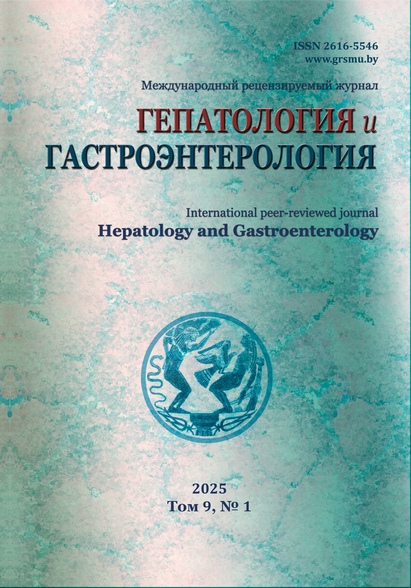APPLICATION OF RISK ANALYSIS METHODOLOGY IN EPIDEMIOLOGICAL AUDITS IN ENDOSCOPY (Report 1)

Abstract
Background. Since endoscopy introduction in the last century the number and significance of endoscopic procedures have substantially increased globally. Concurrently, there has grown the risk of healthcare-associated infections (HAIs) during endoscopic procedures particularly due to equipment failures, breaches in endoscope reprocessing, and noncompliance with established guidelines. Objective. To develop a standardized checklist for epidemiological audits in endoscopy departments/units, based on the risk analysis methodology. Material and methods. The study employed a risk assessment and prioritization framework (WHO, 2021) as its core methodology. Results. A qualitative four-level risk grading scale, marked using a “traffic light” system, was designed and integrated into the checklist. The checklist covered two audit domains: (1) “General Training of Medical Staff” (13 items) and (2) “Assessment of Infrastructure, Equipment, and Technological Processes in Endoscopy Units” (23 items). The developed tool was piloted in nine endoscopy departments across healthcare facilities in the Republic of Belarus. In the first domain, 58 total non-conformities were identified: 47 (81%) classified as Categories A and B, 10 (17%) as Category C, and 1 as Category D. In the second domain, 87 non-conformities were documented: 62 (71%) in Categories A and B, 12 (14%) in Category C, and 13 (15%) in Category D. These findings suggest that a significant proportion of non-conformities remain undetected in routine practice, potentially leading to serious complications and systemic failures over time. Conclusion. The integration of a systematic risk assessment approach through the use of standardized checklists and Standard Operating Procedures (SOPs) creates a synergistic effect that enhances risk management processes. This strategy contributes to improved safety and quality in endoscopy-related healthcare delivery.
References
World Health Organization. Surveillance of health careassociated infections at national and facility levels: practical handbook. Geneva: World Health Organization; 2024. 61 p. Available from: https://iris.who.int/bitstream/handle/10665/379248/9789240101456-eng.pdf?sequence=1
World Health Organization. Global report on infection prevention and control 2024: executive summary. Geneva: World Health Organization; 2024. 16 p. Available from: https://iris.who.int/bitstream/handle/10665/379863/B09195-eng.pdf?sequence=1
Cheung DY, Jang BI, Kim SW, Kim JH, Kim HK, Shin JE, Yoon WJ, Lee YK, Chung KH, Cho SJ, Shin HP, Cho SY, Shin WG, Choi KD, Kim BW, Kwon JG, Yang HC, Gweon TG, Kim HG, Ahn DW, Cho KB, Kim SH, Hwang KH, Im HH. Multidisciplinary and Multisociety Practice Guideline on Reprocessing Flexible Gastrointestinal Endoscopes and Endoscopic Accessories. Clin Endosc. 2020;53(3):276-285. https://doi.org/10.5946/ce.2020.106.
Kenters N, Huijskens EG, Meier C, Voss A. Infectious diseases linked to cross-contamination of flexible endoscopes. Endosc Int Open. 2015;3(4):E259-65. https://doi.org/10.1055/s-0034-1392099.
Scarpaci M, Cosci T, Tuvo B, Guarini A, Iannone T, Zullo A, Casini B. Good Practices on Endoscope Reprocessing in Italy: Findings of a Nationwide Survey. Int J Environ Res Public Health. 2022;19(19):12082. https://doi.org/10.3390/ijerph191912082.
Cottarelli A, De Giusti M, Solimini AG, Venuto G, Palazzo C, Del Cimmuto A, Osborn J, Marinelli L. Microbiological surveillance of endoscopes and implications for current reprocessing procedures adopted by an Italian teaching hospital. Ann Ig. 2020;32(2):166-177. https://doi.org/10.7416/ai.2020.2340.
Beilenhoff U, Neumann CS, Rey JF, Biering H, Blum R, Schmidt V; ESGE Guidelines Committee. ESGE-ESGENA guideline for quality assurance in reprocessing: microbiological surveillance testing in endoscopy. Endoscopy. 2007;39(2):175-81. https://doi.org/10.1055/s-2006-945181.
Ofstead CL, Hopkins KM, Buro BL, Eiland JE, Wetzler HP. Challenges in achieving effective high-level disinfection in endoscope reprocessing. Am J Infect Control. 2020;48(3):309-315. https://doi.org/10.1016/j.ajic.2019.09.013.
Correa CSM, Bagatini A, Prates CG, Sander GB. Patient safety in an endoscopy unit: an observational retrospective analysis of reported incidents. Braz J Anesthesiol. 2021;71(2):137-141. https://doi.org/10.1016/j.bjane.2021.02.023.
Benowitz I, Moulton-Meissner HA, Epstein L, Arduino MJ. The Centers for Disease Control and Prevention Guidance on Flexible Gastrointestinal Endoscopes: Lessons Learned from Outbreaks, Infection Control. Gastrointest Endosc Clin N Am. 2020;30(4):723-733. https://doi.org/10.1016/j.giec.2020.06.009.
Abelskaya IS, Aliakseyeva MG. Protivojepidemicheskaja bezopasnost v endoskopii: problemy i puti ih reshenija v Respublike Belarus [Antiepidemic safety in endoscopy: problems and ways of their solution in the Republic of Belarus]. Zdravoohranenije (Minsk). 2024;(5(926)):17-21. edn: RORDOZ. (Russian).
Chernyavskaya OP, Kononenko NA, Kabakova KN, Obolskaya NM. Metodika razrabotki standartnoj operacionnoj procedury obrabotki gibkogo endoskopa s uchetom epidemiologicheskih riskov [Methodology for the development of a standard operating procedure for reprocessing flexible endoscope, taking into account the epidemiological risks]. Epidemiologija i vakcinoprofilaktika [Epidemiology and Vaccinal Prevention]. 2023;22(6):124-132. https://doi.org/10.31631/2073-3046-2023-22-6-124-132. https://elibrary.ru/mvrkmg. (Russian).
Selkova EP, Grenkova TA, Aleshkin VA, Knyazev MV. Problemy obespechenija infekcionnoj bezopasnosti jendoskopicheskih vmeshatel'stv v organizacijah, osushhestvljajushhih medicinskuju dejatel'nost': puti reshenija [The problems of ensuring safety of infectious endoscopic interventions in organizations engaged in medical activities: ways to solve the problems]. Epidemiologija i vakcinoprofilaktika [Epidemiology and Vaccinal Prevention]. 2011;(4(59)):19-26. edn: NZABKP. (Russian).
Yumtsunova NA, Zhivotneva IV. Infekcionnaja bezopasnost v jendoskopii [New technologies in endoscopy: problems and solutions]. Meditsinskaya sestra. 2015;(6):18-21. edn: UHNFPJ. (Russian).
Tartari E, Tomczyk S, Twyman A, Rehse APC, Gomaa M, Talaat M, Shah AS, Sobel H, Toledo JP, Allegranzi B. Evaluating national infection prevention and control minimum requirements: evidence from global cross-sectional surveys, 2017-22. Lancet Glob Health. 2024;12(10):e1620-e1628. https://doi.org/10.1016/S2214-109X(24)00277-8.
World Health Organization, Food and Agriculture Organization of the United Nations, World Organisation for Animal Health. Joint Risk Assessment Operational Tool (JRA OT): An Operational Tool of the Tripartite Zoonoses Guide: Taking a Multisectoral, One Health Approach: A Tripartite Guide to Addressing Zoonotic Diseases in Countries. Available from: https://iris.who.int/bitstream/handle/10665/340005/9789240015142-eng.pdf?sequence=1
World Health Organization. Assessment tool of the minimum requirements for infection prevention and control programmes at the national level. Available from: https://cdn.who.int/media/docs/default-source/integrated-healthservices-(ihs)/ipc/ipc-global-survey---national-level-2021/minimum-requirements-for-national-infection-preventionand-contorl-programmes_v7.final_with_logo.pdf
World Health Organization. Strategic toolkit for assessing risks: a comprehensive toolkit for all-hazards health emergency risk assessment. Geneva: World Health Organization; 2021. 71 p. Available from: https://iris.who.int/bitstream/handle/10665/348763/9789240036086-eng.pdf?sequence=1

















1.png)






